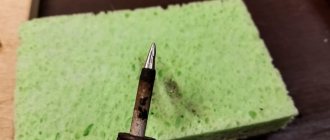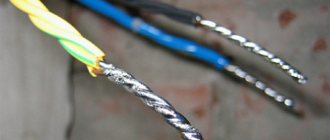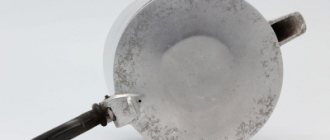Using a homemade sting
To save money, many craftsmen decide to create a homemade tip. The operating principle of the soldering iron is quite simple:
- There is a heating element that receives power from the power supply.
- Heat is transferred to the sting, which has a pointed shape.
- When the tip comes into contact with the material being processed, it heats up and becomes plastic.
You can make a homemade design as follows:
- A piece of copper wire is required, which has a diameter of about 0.5 cm. A conductor can be used as a tip, one end of which is sharpened at an angle of 45 degrees. A small piece of fabric that is temperature resistant is also required.
- One end of the cable is insulated. It will be used as a handle. Fiberglass is often used as an insulating material. Fixation is carried out using heat-resistant glue.
Homemade sting
Soldering without a soldering iron can be carried out using a fire source, for example, a gas stove. Using fire, the tip is heated, after which you need to touch the solder or rosin. Due to the use of a special material, the tip will become tinned and the tip can be used as a soldering iron.
How is rosin obtained?
Rosin is obtained from oleoresin - a resinous substance (turpentine) released when the tissue of coniferous trees is wounded, followed by evaporation of volatile substances from the raw resin, mainly turpentine. Typically, the ratio of rosin to turpentine in raw resin is 3:1.
Interesting materials:
Do you need a backup on your iPhone? Do I need to putty on smooth concrete walls? Do neighbors need consent to install a camera? Do I need to put double parentheses? Should I put a comma before including? Should I put a comma after there? Should I put a comma after only? Do I need to study for category BE? Do I need to notify the employment center about employment? Do I need to enable Google sync?
Solder the garland using improvised means
Problems often arise with garlands that are used to decorate a home or tree. Due to the use of thin wires, they are often interrupted and soldering is required. Among the features of this work, we note the following points:
- In most cases, the problem occurs in the control unit, since the wires are not attached securely.
- A breakthrough may occur along the entire length of the product.
- If all light sources are connected in parallel, then the failure of only one leads to an open circuit of the entire circuit.
It’s quite easy to find loose contacts, but a break is only possible when using a tester. Only after finding the break point can you start soldering. You can solder without a soldering iron as follows:
- The broken wires should be cleaned.
- You can make a small twist on which the paste is applied. It will be used to distribute the alloy used.
- The next step is to melt the solder, which can be done using a lighter or a candle.
- After this, the junction is isolated using a tube, which is also slightly heated to increase its ductility.
Similar technology can be used to restore the condition of headphones. The soldering procedure does not take much time.
How to replace solder for soldering?
Many experts consider the most affordable option to be the use of pharmacy aspirin. Please note that it will not be possible to replace rosin with effervescent tablets. They contain fillers (sodium compounds) that are not needed for soldering. Therefore, the most common simple aspirin is used.
Interesting materials:
What can you sell in spring? What can you plant in the garden in early spring? What can you plant in spring? What can be sown in a greenhouse in early spring? What can you collect in the forest in spring? What should a woman wear in spring 2021? What do you need for running in the spring? What do you need to care for currants in spring? What about inanimate nature in spring? What to see in Kazan in 3 days in spring?
Soldering wires without using a soldering iron
Wires are prone to breakage. You can solder a wire without a soldering iron if you take into account several recommendations:
- To begin with, the break point is located and the ends are cleaned.
- After this, the wires are twisted together to create a strong connection.
- The area being treated should be slightly warmed up. To do this, you can use a lighter or other heat source.
- The solder is also heated to a plastic state, after which it is applied to the joint.
When working with large-section wires, you should grind the solder and sprinkle it on the surface, then heat the surface with a candle or lighter. In this case, the solder fills the free space, thereby ensuring reliable contact. When considering how to solder without a soldering iron, you should take into account the fact that only wires with a diameter of 2 mm can be processed in this way.
Soldering wires without a soldering iron
If you need to solder a flat element, then the parts are pre-tinned. At the time of soldering, the core is pressed and sprinkled with shavings of the selected alloy, after which the surface is heated.
What is solder?
Solder is a mixture of low-melting metals that are capable of providing good contact between two surfaces, resulting from soldering. When heated, solder changes from a solid to a liquid state, which ensures spreading around the perimeter of the soldered part or at the point of their contact. In this case, fixation occurs at the molecular level due to a high degree of adhesion.
In terms of composition, solders can include a variety of components that provide them with the necessary performance properties. However, the vast majority consists of a mixture of lead and tin, the first of which provides hardness and refractoriness, and the second lightness and lowers the melting point. The composition may also contain other components: silver, nickel, zinc, copper, kobold, bismuth, antimony and others.
Due to the multi-component composition, the melting process also goes through several stages: first, the most fusible components are rarefied, while the refractory ones remain in the form of crystals at this moment. Then they melt, the mixture becomes homogeneous and ensures maximum filling and contact. However, fluxes are used in conjunction with solder to provide better filling and oxidation protection.
Features of soldering in the groove
If you need to process wires with a diameter of up to 3 mm, you can do without a soldering iron; grooves are used for this. They can be made from aluminum foil, the thickness of which is 0.8 mm. Recommendations for soldering at home in this case are as follows:
- Insulating materials are removed.
- The damaged ends should be twisted together and then laid parallel.
- A groove is made from foil that will cover the joint. It is used for solder distribution. It is recommended to use shavings.
- The foil trough is heated with a candle or lighter. In this case, you need to be careful, as molten metal may leak out and cause burns. When working, it is recommended to use pliers.
If necessary, solder that has leaked out can be protected with sandpaper. The use of foil significantly increases the degree of insulation.
Soldering utensils or containers
Often there is a need to carry packs of dishes and other containers. Without a suitable soldering iron, work can only be done if the hole has a diameter of 6 mm. Among the features of the procedure, we note the following points:
- POS60 is used as solder. This alloy is characterized by more attractive performance characteristics; the created patch can withstand significant mechanical stress.
- The area around the defect is cleaned. It is recommended to create a surface that resembles a funnel.
- Treatment is carried out using hydrochloric acid. It is able to remove all contaminants from the surface being treated.
- It is recommended to place a plate on the reverse side that will prevent solder from leaking out. After the alloy hardens, the plate is removed.
Solder POS-60 1mm
As before, the solder should be made with shavings that fill the hole. After this, the problem area is heated using a lamp or other heat source.
Solder paste for soldering without a soldering iron; application features
There is a special paste on sale that can be used as solder. In addition, you can make it yourself. Among the features of the work carried out, we note the following points:
- The area being treated is cleaned. The insulation is removed from each wire. After this, it is necessary to degrease, since soot may remain on the surface of the veins.
- Using a brush or other similar tool, apply the paste. It is worth considering that it must be distributed evenly over the entire surface of the connection. The brush is selected depending on the cross-section of the wire.
- The area where the paste was applied heats up. To heat up the solder, a hair dryer or a homemade sting or a regular lighter can be used as a heater. It is necessary to ensure that the substance does not boil, as this can lead to a change in its basic properties.
Soldering paste without a soldering iron
The composition of the paste you create yourself may vary somewhat depending on the area of application. After exposure to high temperature, the paste becomes a solid material that is resistant to mechanical and other stress.
Using Alternative Soldering Media
Soldering work is standard for any chosen product; differences can only be observed at the preparatory stage:
- the fat must be melted or heated;
- prepare a solution from aspirin;
- No preparation is required for resin, amber, and bow rosin.
The use of analogues cannot be a complete replacement for soldering rosin, however, when you don’t have it at hand, they will be an ideal way to achieve the desired result.
You also need to take into account that home methods are not suitable for production purposes. The quality of soldering will be significantly worse than when using standard soldering.
Foil as a soldering method
The soldering method using foil is characterized by practicality. Typically, it only takes 5 minutes to restore the connection. Foil can be used as solder, which is unwound over the entire area and heated to a high temperature. Due to this, the plasticity of the material increases significantly; after cooling, it hardens.
Foil can be used in a variety of cases. An example is damage to the board or wire connection. Among the features of the work carried out, we note the following points:
- Standard contact preparation is carried out.
- The ends are twisted to form a joint. Due to this, the reliability of the connection is significantly increased.
- The required amount of foil is cut off, the junction is wrapped in several skeins.
After this, uniform heating is carried out using a hair dryer or other heat source. When exposed to heat, the surface of the foil quickly becomes soft and plastic; after heating stops, it quickly cools and hardens, providing the required degree of sealing and strength.
In conclusion, we note that without a soldering iron it is almost impossible to carry out jewelry work, as well as soldering circuit boards. This is due to the lack of possibility of directed heat exposure. However, in some cases a soldering iron and other tools are not required.
Manufacturing instructions
We prepare solder for soldering silver with our own hands. Since a burner is used to melt refractory elements, we do this in a garage or workshop. Silver solder consists of 2 elements:
- silver in the amount of 3 grams;
- brass (copper + zinc) 1 gr.
Silver must be as pure as possible - 925. As brass, you can use broken brass products and coins. Or take a ratio of 70% copper and 30% zinc. The two-component alloy should be in exactly this ratio, since when the zinc content increases to 40%, brittleness increases.
It is necessary to melt the elements first of all that have a high melting point and add the rest as they decrease. The melting point of copper is 1080° C, silver – 930° C, zinc – 420° C.
To produce homemade solder, we will need a small mold and a bowl in which we will melt. It's best if it's cast iron. Warm up the mold and add a little wax to it, heat the bowl. If we use ready-made brass, then melting begins with silver. If these are 3 separate elements, then we start melting with copper. If the melting is not complete, add silver; when mixing, the process begins to happen faster. Finally add zinc. Without ceasing to heat the bowl of metal, we pour the resulting melt into the mold. Cooling of the melt occurs very quickly, in a matter of seconds. After crystallization, the resulting workpiece can be cooled.
How can I replace tin solder for soldering? This category is characterized by high ductility and adhesion to metal surfaces. Low refractoriness allows the use of solder for non-ferrous metals and thin parts. A mixture is obtained by mixing tin and lead in their pure form. The elements themselves can be obtained chemically by extracting tin from cans and lids. We do it step by step:
- Pour water into a jar, put it on fire and boil. Mine.
- We connect 3 batteries and a 9-2 volt battery. We connect the positive pole to the jar, the negative pole to metal of any shape (let it be an electrode).
- Fill the jar with sodium hydroxide or soda solution.
- We lower the electrode into the jar, but so that it does not touch its walls.
- Over time, a deposit of pure tin will appear on the anode (electrode).











